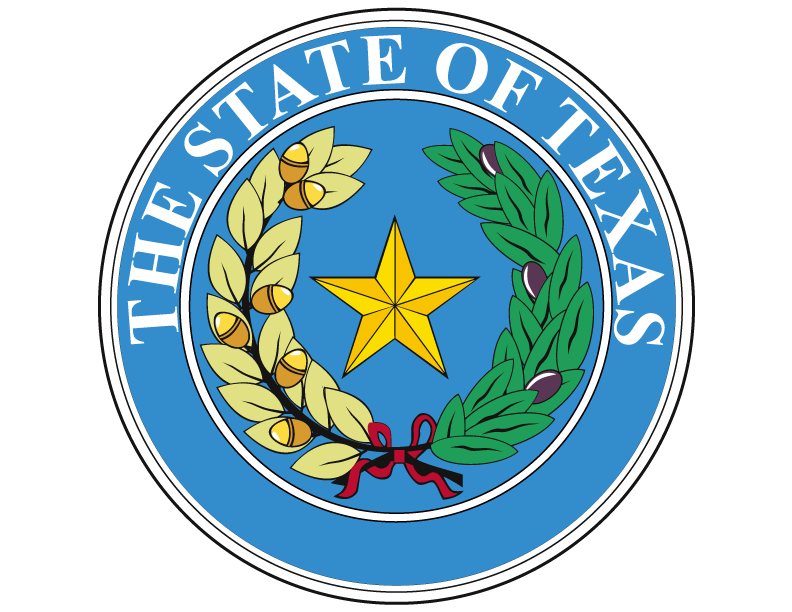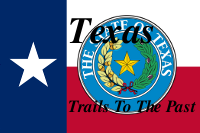
|
|||
| site search by freefind |
Forms:
Please use these forms to submit data for TexasTTTP
General Information
Texas History & Genealogy
Family Group Sheets
Leaton Clark Collection
Guerrero-Vasquez Family
African American
Native Americans
News
Stories & Traditions
Projects
Cherokee Strip Live Stock Association
NEIGHBORING STATES
New Mexico
 |
TexasThe Lone Star State |
 |
| Texas History |
The History is of Texas is much too rich and colorful to ever do it justice in such a setting. All that can be done here is a bare outline.
Texas lies between two major cultural spheres of Pre-Columbian North America: the Southwestern and the Plains areas. Archaeologists have found that three major indigenous cultures lived in this territory, and reached their developmental peak before the first European contact. These were: the Pueblo from the upper Rio Grande region, centered west of Texas; the Mississippian culture, also known as Mound Builder, which extended along the Mississippi River Valley east of Texas; and the civilizations of Mesoamerica, centered south of Texas. Influence of Teotihuacan in northern Mexico peaked around AD 500 and declined over the 8th to 10th centuries.
The first historical document related to Texas was a map of the Gulf Coast, created in 1519 by Spanish explorer Alonso �lvarez de Pineda. Nine years later, shipwrecked Spanish explorer �lvar N��ez Cabeza de Vaca and his cohort became the first Europeans in Texas. European powers ignored Texas until accidentally settling there in 1685. Miscalculations by Ren� Robert Cavelier de La Salle resulted in his establishing the colony of Fort Saint Louis at Matagorda Bay rather than along the Mississippi River. The colony lasted only four years before succumbing to harsh conditions and hostile natives.
In 1690 Spanish authorities, concerned that France posed competitive threat, constructed several missions in East Texas. After Native American resistance, the Spanish missionaries returned to Mexico. When France began settling Louisiana, mostly in the southern part of the state, in 1716 Spanish authorities responded by founding a new series of missions in East Texas. Two years later, they created San Antonio as the first Spanish civilian settlement in Texas.
Within Mexico, tensions continued between federalists and centralists. In early 1835, wary Texians formed Committees of Correspondence and Safety. The unrest erupted into armed conflict in late 1835 at the Battle of Gonzales. This launched the Texas Revolution, and over the next two months, the Texians successfully defeated all Mexican troops in the region. Texians elected delegates to the Consultation, which created a provisional government. The provisional government soon collapsed from infighting, and Texas was without clear governance for the first two months of 1836.
During this time of political turmoil, Mexican President Antonio Lopez de Santa Anna personally led an army to end the revolt. The Mexican expedition was initially successful. General Jose de Urrea defeated all the Texian resistance along the coast culminating in the Goliad Massacre. Santa Anna's forces, after a thirteen-day siege, overwhelmed Texian defenders at the Battle of the Alamo. News of the defeats sparked panic amongst Texas settlers. The newly-elected Texian delegates to the Convention of 1836 quickly signed a Declaration of Independence on March 2, forming the Republic of Texas. After electing interim officers, the Convention disbanded. The new government joined the other settlers in Texas in the Runaway Scrape, fleeing from the approaching Mexican army. After several weeks of retreat, the Texian Army commanded by Sam Houston attacked and defeated Santa Anna's forces at the Battle of San Jacinto. Santa Anna was captured and forced to sign the Treaties of Velasco, ending the war.
As early as 1837, the Republic made several attempts to negotiate annexation with the United States. Opposition within the republic from the nationalist faction, along with strong abolitionist opposition within the United States, slowed Texas's admission into the Union. Texas was finally annexed when the expansionist James K. Polk won the election of 1844. On December 29, 1845, Congress admitted Texas to the U.S. as a constituent state of the Union.
In keeping with the
policy
of providing free information on the Internet, data may be used by
non-commercial entities. These electronic pages may NOT be reproduced
in any format for profit or for presentation by other persons or
organizations. This site may NOT be linked to from a pay site. All data
submitted to the Texas Trails To The Past remains copyright by the
submitter.
If there are any questions, please e-mail the Texas, Trails To The Past Administrator and Asst. Administrator
Copyright 2010 - 2025 | All Rights Reserved
If there are any questions, please e-mail the Texas, Trails To The Past Administrator and Asst. Administrator
Copyright 2010 - 2025 | All Rights Reserved